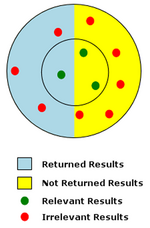|
Full-text search
In text retrieval, full-text search refers to techniques for searching a single computer-stored document or a collection in a full-text database. Full-text search is distinguished from searches based on metadata or on parts of the original texts represented in databases (such as titles, abstracts, selected sections, or bibliographical references). In a full-text search, a search engine examines all of the words in every stored document as it tries to match search criteria (for example, text specified by a user). Full-text-searching techniques appeared in the 1960s, for example IBM STAIRS from 1969, and became common in online bibliographic databases in the 1990s.[verification needed] Many websites and application programs (such as word processing software) provide full-text-search capabilities. Some web search engines, such as the former AltaVista, employ full-text-search techniques, while others index only a portion of the web pages examined by their indexing systems.[1] IndexingWhen dealing with a small number of documents, it is possible for the full-text-search engine to directly scan the contents of the documents with each query, a strategy called "serial scanning". This is what some tools, such as grep, do when searching. However, when the number of documents to search is potentially large, or the quantity of search queries to perform is substantial, the problem of full-text search is often divided into two tasks: indexing and searching. The indexing stage will scan the text of all the documents and build a list of search terms (often called an index, but more correctly named a concordance). In the search stage, when performing a specific query, only the index is referenced, rather than the text of the original documents.[2] The indexer will make an entry in the index for each term or word found in a document, and possibly note its relative position within the document. Usually the indexer will ignore stop words (such as "the" and "and") that are both common and insufficiently meaningful to be useful in searching. Some indexers also employ language-specific stemming on the words being indexed. For example, the words "drives", "drove", and "driven" will be recorded in the index under the single concept word "drive". The precision vs. recall tradeoff Recall measures the quantity of relevant results returned by a search, while precision is the measure of the quality of the results returned. Recall is the ratio of relevant results returned to all relevant results. Precision is the ratio of the number of relevant results returned to the total number of results returned. The diagram at right represents a low-precision, low-recall search. In the diagram the red and green dots represent the total population of potential search results for a given search. Red dots represent irrelevant results, and green dots represent relevant results. Relevancy is indicated by the proximity of search results to the center of the inner circle. Of all possible results shown, those that were actually returned by the search are shown on a light-blue background. In the example only 1 relevant result of 3 possible relevant results was returned, so the recall is a very low ratio of 1/3, or 33%. The precision for the example is a very low 1/4, or 25%, since only 1 of the 4 results returned was relevant.[3] Due to the ambiguities of natural language, full-text-search systems typically includes options like filtering to increase precision and stemming to increase recall. Controlled-vocabulary searching also helps alleviate low-precision issues by tagging documents in such a way that ambiguities are eliminated. The trade-off between precision and recall is simple: an increase in precision can lower overall recall, while an increase in recall lowers precision.[4] False-positive problemFull-text searching is likely to retrieve many documents that are not relevant to the intended search question. Such documents are called false positives (see Type I error). The retrieval of irrelevant documents is often caused by the inherent ambiguity of natural language. In the sample diagram to the right, false positives are represented by the irrelevant results (red dots) that were returned by the search (on a light-blue background). Clustering techniques based on Bayesian algorithms can help reduce false positives. For a search term of "bank", clustering can be used to categorize the document/data universe into "financial institution", "place to sit", "place to store" etc. Depending on the occurrences of words relevant to the categories, search terms or a search result can be placed in one or more of the categories. This technique is being extensively deployed in the e-discovery domain.[clarification needed] Performance improvementsThe deficiencies of full text searching have been addressed in two ways: By providing users with tools that enable them to express their search questions more precisely, and by developing new search algorithms that improve retrieval precision. Improved querying tools
Improved search algorithmsThe PageRank algorithm developed by Google gives more prominence to documents to which other Web pages have linked.[6] See Search engine for additional examples. SoftwareThe following is a partial list of available software products whose predominant purpose is to perform full-text indexing and searching. Some of these are accompanied with detailed descriptions of their theory of operation or internal algorithms, which can provide additional insight into how full-text search may be accomplished. Free and open source softwareProprietary softwareReferences
See also
|